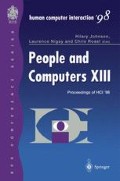Abstract
For the last twenty years, human-computer interfaces have been dominated by two-dimensional interaction techniques. Things are changing. Techniques that were previously restricted to specialized CAD/CAM tools and immersive VR systems are now being extended to the mass market. The photo-realistic facilities offered by QuicktimeVR and the model based renderings of VRML (Virtual Reality Mark-up Language) provide sophisticated tools for interface design. As a result, three dimensional visualization techniques are being widely exploited in the financial services industry, airports and even off-shore oil production. In January 1997, there were some 2,000 VRML models on the web. By January 1998, this number had grown to over 20,000. Research in human-computer interaction has, however, lagged behind these developments. Few guidelines can be applied to support the design of desktopVR. This paper, therefore, describes three criteria that can be applied to assess the usability of these interfaces. We then go on to validate these criteria against a number of case studies. Unfortunately, it is concluded that standard measures of task performance, successful navigation and subjective satisfaction cannot easily be applied to assess the utility of 3D systems.
Access this chapter
Tax calculation will be finalised at checkout
Purchases are for personal use only
Preview
Unable to display preview. Download preview PDF.
References
Benford, S., Bullock, A., Cook, N., Harvey, P., Ingram, R. and Lee, O. (1993), “From Rooms to Cyberspace: Models of Interaction in Large Virtual Computer Spaces”, Interacting with Computers 5 (2), 217–37.
Duke, D. (1998), “INQUISITIVE Project”. EPSRC award 12/97, See http://www.cs.york.ac.ulcrduke/inqu.html.
Gibson, J. (1971), “The Information Available in Pictures”, Leonardo 4, 27–35.
Gordon, I. (1990), Theories of Visual Perception,John Wiley and Sons.
Johnson, C. (1997a), Electronic Gridlock, Information Saturation and the Unpredictability of Information Retrieval Over the World Wide Web, in F. Patemo’ and P. Palanque (eds.), Formal Methods in Human Computer Interaction: Comparisons, Benefits, Open Questions, Springer-Verlag, pp. 261–82.
Johnson, C. (1997b), Ten Golden Rules for Video over the Web, in J. Ratner, E. Grosse and C. Forsythe (eds.), Human Factors for World Wide Web Development, Lawrence Erlbaum Associates, pp. 207–24.
Mackinlay, J., Robertson, G. and Card, S. (1991), The Perspective Wall, in S. P. Robertson, G. M. Olson and J. S. Olson (eds.), Proceedings of CHI’91: Human Factors in Computing Systems (Reaching through Technology), ACM Press, pp. 173–9.
Neal, L. (1990), The Implications of Computer Games for System Design, in D. Diaper, D. Gilmore, G. Cockton and B. Shackel (eds.), Proceedings of INTERACT’90 — Third IFIP Conference on Human–Computer Interaction, Elsevier Science, pp. 93–9.
Sutcliffe, A. and Patel, U. (1993), The Three Dimensional Graphical User Interface Evaluation for Design Evolution, in J. Alty, D. Diaper and S. Guest (eds.), People and Computers VIII (Proceedings of HCI’93), Cambridge University Press, pp. 311–34.
Sutcliffe, A. G. and Patel, U. (1996), 3D or not 3D: Is it Nobler in the Mind?, in A. Sasse, R. J. Cunningham and R. Winder (eds.), People and Computers XI (Proceedings of HCI’96),Springer-Verlag, pp.79–94.
Tweedie, L. (1995), Interactive Visual Artefacts: How can Abstractions inform Design?, in M. A. R. Kirby, A. J. Dix and J. E. Finlay (eds.), People and Computers X (Proceedings of HCI’95), Cambridge University Press, pp. 247–65.
van Teylingen, R., Ribarsky, W. and van der Mast, C. (1995), Virtual Data Visualizer, Technical Report 95–16, Georgia Tech.
Author information
Authors and Affiliations
Editor information
Editors and Affiliations
Rights and permissions
Copyright information
© 1998 Springer-Verlag London
About this paper
Cite this paper
Johnson, C. (1998). On the Problems of Validating DesktopVR. In: Johnson, H., Nigay, L., Roast, C. (eds) People and Computers XIII. Springer, London. https://doi.org/10.1007/978-1-4471-3605-7_21
Download citation
DOI: https://doi.org/10.1007/978-1-4471-3605-7_21
Publisher Name: Springer, London
Print ISBN: 978-3-540-76261-4
Online ISBN: 978-1-4471-3605-7
eBook Packages: Springer Book Archive

